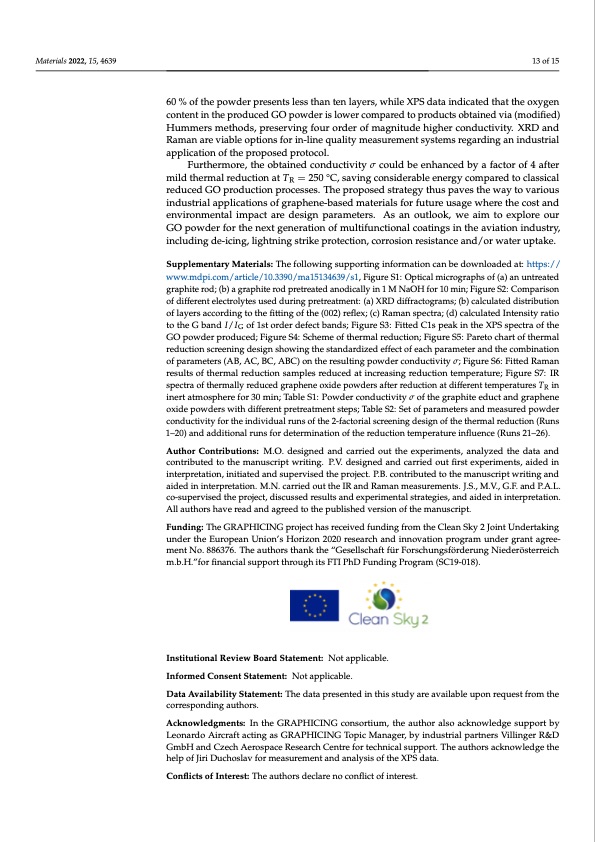
PDF Publication Title:
Text from PDF Page: 013
Materials 2022, 15, 4639 13 of 15 60 % of the powder presents less than ten layers, while XPS data indicated that the oxygen content in the produced GO powder is lower compared to products obtained via (modified) Hummers methods, preserving four order of magnitude higher conductivity. XRD and Raman are viable options for in-line quality measurement systems regarding an industrial application of the proposed protocol. Furthermore, the obtained conductivity σ could be enhanced by a factor of 4 after mild thermal reduction at TR = 250 °C, saving considerable energy compared to classical reduced GO production processes. The proposed strategy thus paves the way to various industrial applications of graphene-based materials for future usage where the cost and environmental impact are design parameters. As an outlook, we aim to explore our GO powder for the next generation of multifunctional coatings in the aviation industry, including de-icing, lightning strike protection, corrosion resistance and/or water uptake. Supplementary Materials: The following supporting information can be downloaded at: https:// www.mdpi.com/article/10.3390/ma15134639/s1, Figure S1: Optical micrographs of (a) an untreated graphite rod; (b) a graphite rod pretreated anodically in 1 M NaOH for 10 min; Figure S2: Comparison of different electrolytes used during pretreatment: (a) XRD diffractograms; (b) calculated distribution of layers according to the fitting of the (002) reflex; (c) Raman spectra; (d) calculated Intensity ratio to the G band I/IG of 1st order defect bands; Figure S3: Fitted C1s peak in the XPS spectra of the GO powder produced; Figure S4: Scheme of thermal reduction; Figure S5: Pareto chart of thermal reduction screening design showing the standardized effect of each parameter and the combination of parameters (AB, AC, BC, ABC) on the resulting powder conductivity σ; Figure S6: Fitted Raman results of thermal reduction samples reduced at increasing reduction temperature; Figure S7: IR spectra of thermally reduced graphene oxide powders after reduction at different temperatures TR in inert atmosphere for 30 min; Table S1: Powder conductivity σ of the graphite educt and graphene oxide powders with different pretreatment steps; Table S2: Set of parameters and measured powder conductivity for the individual runs of the 2-factorial screening design of the thermal reduction (Runs 1–20) and additional runs for determination of the reduction temperature influence (Runs 21–26). Author Contributions: M.O. designed and carried out the experiments, analyzed the data and contributed to the manuscript writing. P.V. designed and carried out first experiments, aided in interpretation, initiated and supervised the project. P.B. contributed to the manuscript writing and aided in interpretation. M.N. carried out the IR and Raman measurements. J.S., M.V., G.F. and P.A.L. co-supervised the project, discussed results and experimental strategies, and aided in interpretation. All authors have read and agreed to the published version of the manuscript. Funding: The GRAPHICING project has received funding from the Clean Sky 2 Joint Undertaking under the European Union’s Horizon 2020 research and innovation program under grant agree- ment No. 886376. The authors thank the “Gesellschaft für Forschungsförderung Niederösterreich m.b.H.”for financial support through its FTI PhD Funding Program (SC19-018). InstitutionalReviewBoardStatement: Notapplicable. InformedConsentStatement: Notapplicable. Data Availability Statement: The data presented in this study are available upon request from the corresponding authors. Acknowledgments: In the GRAPHICING consortium, the author also acknowledge support by Leonardo Aircraft acting as GRAPHICING Topic Manager, by industrial partners Villinger R&D GmbH and Czech Aerospace Research Centre for technical support. The authors acknowledge the help of Jiri Duchoslav for measurement and analysis of the XPS data. Conflicts of Interest: The authors declare no conflict of interest.PDF Image | Electrochemical Production Thermal Reduction Graphene Oxide

PDF Search Title:
Electrochemical Production Thermal Reduction Graphene OxideOriginal File Name Searched:
materials-15-04639.pdfDIY PDF Search: Google It | Yahoo | Bing
Salgenx Redox Flow Battery Technology: Power up your energy storage game with Salgenx Salt Water Battery. With its advanced technology, the flow battery provides reliable, scalable, and sustainable energy storage for utility-scale projects. Upgrade to a Salgenx flow battery today and take control of your energy future.
| CONTACT TEL: 608-238-6001 Email: greg@infinityturbine.com | RSS | AMP |